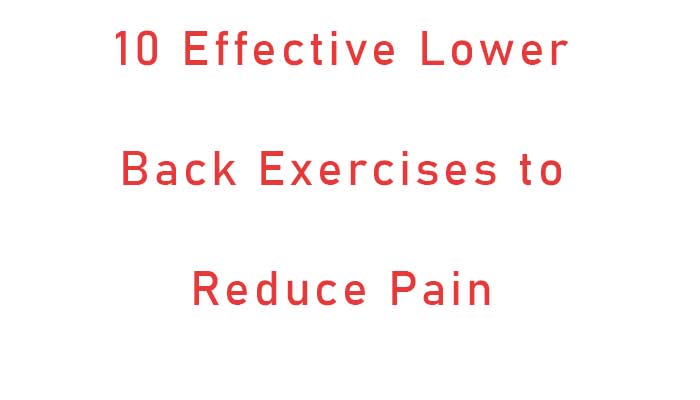
Lower back pain is among the most frequent musculoskeletal ailments in the globe. Persistent lumbar pain whether caused by bad posture, extended sitting, a lack of exercise, or overexertion, interferes with everyday tasks and lowers quality of life.
What is the good news? You have the ability to address this problem with no pricey equipment, no gimmicks. The solution is movement. Strategic, well-executed workouts can considerably alleviate lower back pain, strengthen surrounding muscles, and prevent further discomfort.
This guide explains how to perform proven, effective lower back exercises that focus on core stability, hip flexibility, and spinal alignment. Start adding these workouts into your routine and you’ll not only relieve discomfort but also regain control of your mobility and strength.
1. Pelvic Tilts
Pelvic tilts help strengthen abdominal muscles and support the spine.
How it Works?
- Lie on your back, knees bent, feet flat on the floor.
- Engage your core by drawing your belly button towards your spine.
- To flatten your lower back, tilt your pelvic slightly upwards.
- Hold for 5 – 10 seconds and then release.
- 10 – 15 reps over 2 to 3 sets.
Why Does it Work?
Pelvic tilts activate the deep abdominal muscles that support the spine. They are safe and soft, making them ideal for people in the early stages of back pain treatment.
2. Bridges (Glute Bridges)
Strengthens the glutes and lower back which reduces strain on the lumbar spine.
How it Works?
- Lie on your back, knees bent, feel shoulder-width apart.
- Keep arms by your sides and palms down.
- Push through your heels and elevate your hips to the ceiling.
- Squeeze your glutes at the top for 2 – 3 seconds.
- Slowly lower back down.
- 10 – 15 reps in three sets.
Why Does it Work?
Weak glutes cause the lower back to compensate. This simple but powerful exercise restores muscle balance and gives long-term relief.
3. Bird-Dog
Improves core stability and coordination while reducing asymmetrical strain.
How it Works?
- Assume a tabletop position (hands under shoulders, knees under hips).
- Extend your right arm forward and your left leg backward.
- To avoid twisting, keep your hips level.
- Hold for 5 seconds before returning to start.
- Alternate sides.
- 10 repetitions per side for two sets.
Why Does it Work?
Bird-dog is a key component of back treatment. It teaches your body to steady throughout movement which is essential for reducing lower back discomfort.
4. Cat-Cow Stretch
Improves spine mobility and reduces tension.
How it Works?
- Get on all fours.
- Inhale, arch your back (cow posture), and lift your head and tailbone.
- Exhale and round your spine (cat position) while tucking your chin and pelvis.
- Move gently and with control.
- 10 – 15 complete cycles.
Why Does it Work?
This dynamic stretch increases flexibility and lubricates spinal joints which relieves stiffness and improves posture.
5. Child’s Post (Restorative Stretch)
The purpose is to gently stretch the lower back and hips.
How it Works?
- Kneel on the floor with big toes touching.
- Sit back on your heels and extend your arms forward.
- Rest your forehead on the carpet.
- Take a deep breath and hold for 30 seconds to 1 minute.
- Repeat for 2 – 3 cycles.
Why Does it Work?
Child’s post relieves spinal compression and provides rapid relief for backaches. It also relaxes the nerve system which is important for dealing with pain.
6. Knee-to-Chest Stretch
Relaxes tense lower back muscles.
How it Works?
- Lie on your back with knees bent.
- Bring one knee to your chest while maintaining the other foot flat on the floor.
- Hold the stretch for 20 – 30 seconds and swap sides.
- Repetitions of 3 – 4 per leg.
Why Does it Work?
A tight lumbar spine requires room. This stretch softly decompresses the vertebrae and increases circulation.
7. Piriformis Stretch
To target deep glute muscles that can aggravate the sciatic nerve.
How it Works?
- Lie on your back, knees bent.
- Cross right ankle across left thigh.
- Gently lift your left thigh toward your chest.
- Hold for 30 seconds and swap legs.
- Repetitions of 2 – 3 per side.
Why Does it Work?
Tight piriformis muscles can cause or worsen sciatica. This stretch relieves nerve pressure and lower back stiffness.
8. Wall Sits
Increases endurance of your core, glutes, and quads.
How it Works?
- Stand with your back against a wall.
- Assume a sitting position with knees at 90-degree.
- Put your back flat against the wall and engage your core muscles.
- Hold for 20 – 30 seconds.
- Repeat for 2 – 3 cycles.
Why Does it Work?
Wall sits enhance posture and teach your body to remain aligned under weight. They are low-impact and suitable for the majority of back pain sufferers.
9. Hip Flexor Stretch
Releases tension in the front of the hips which is often a hidden source of back pain.
How it Works?
- Kneel on one knee with the other foot forward.
- Maintain a straight spine while shifting your hips forward.
- Feel a stretch at the front of your hip.
- Hold for 30 seconds and switch sides.
- Repetition of 2 – 3 per side.
Why Does it Work?
Sitting tightens the hip flexors which strain on the lower back. This stretch improves balance and mobility in the front body.
10. Dead Bug
Improves core control while protecting the spine.
How it Works?
- Lie on your back with your arms extended toward the ceiling and your knees bent 90 degrees.
- Slowly lower your right arm and left leg to the floor.
- Maintain a flat back and avoid arching.
- Alternate sides and return to the starting point.
- Repetitions of 8 – 10 per side.
Why Does it Work?
Unlike crunches which can strain the back, dead bug exercises improve deep core stabilizers while keeping the spine neutral. It’s a necessary move for pain management.
Key Principles to Gain Maximum Benefits
Consistency Trumps Intensity
These activities aren’t one-and-done. To retain your body, you must practice them on a consistent basis, 3 to 5 times each week. Don’t wait until the discomfort worsens.
Form Is Not Negotiable
Sloppy movement is more harmful than beneficial. Prioritize slow, controlled movements. If it hurts (sharp pain, not muscular exertion), pause and reconsider.
Balanced Movement and Recovery
Strengthening and stretching should go hand in hand. Overtraining can cause inflammation in an already sensitive back. Include recovery days and restorative stretches.
Integrate Exercise With Lifestyle Changes
No amount of exercise will make up for hours of sitting every day. Get up every 30 minutes. Walk or use a lumbar-supporting chair. Take control of your daily habits.
You don’t have to accept persistent lower back pain as a fact of life. You have tools that are powerful, accessible, and effective. These exercises, that are based on clinical research and best practices in physical therapy, provide a long-term solution for pain and resilience.

Leave a Reply